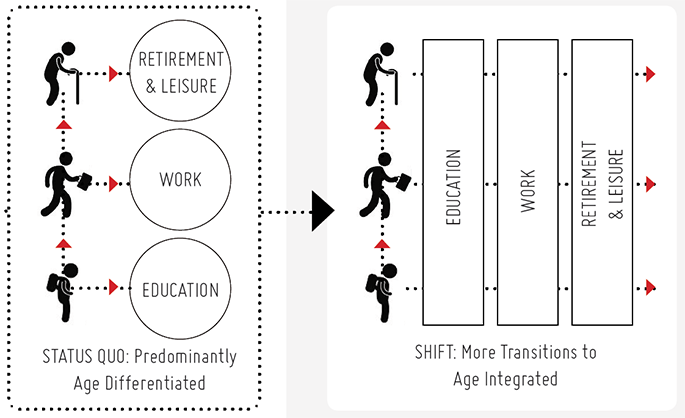Understanding of workplace discrimination against older workers has increased greatly over the last thirty years. Powerful organizations such as the AARP have successfully fought for the rights of older workers. Many people have heard about a problem of older workers being pushed out of the work force in favor of younger workers. This theme is repeated in sitcoms and Op-Eds across the country. This form of age discrimination is well understood and many laws and powerful interests work to address the problems caused by ageism targeting older workers.
The problems faced by younger workers are less understood. Ageism is a double-edged sword that cuts against the old as well as the young. Young workers face significant barriers in finding a job, getting paid a fair wage and in receiving promotions and equal respect on the job. Some of these barriers are the result of unconscious assumptions, biases and stereotypes that employers hold against young workers, others are put in place by law and by corporate policy. Unlike discrimination against older workers, these barriers are not seen as unfair, indeed they are so common place they are hardly noticed. However they have profound, negative consequences for workers, companies and the economy as a whole.
How big of a problem is this? According to a 2002 survey by Mercer Human Resource Consulting, only 44% of employees aged 18 to 24 believe they were treated fairly on the job compared to 64% of workers 45 to 55. This 20 point difference is quite significant and a sign that young workers face far more barriers at work than older adults. The fact that 56% of younger workers didn’t think they were treated fairly is indeed the sign of a pervasive problem.
Younger workers may have a general sense that something is unfair, but few understand the root cause. Unlike other countries where discrimination against the young is widely understood and addressed, very little attention is being paid to this critical issue in the United States. Comprehensive surveys have yet to be done and workers themselves may not fully understand that their age is the reason they have fewer opportunities in the working world.
Discrimination is more overt and severe the younger a worker is, however this problem affects a wide range of workers. Indeed, as Dennis Cline, a worker at General Dynamics Land Systems, Inc. found, even workers in their 40’s can face serious consequences for being too young. In 1997 his employer severely cut retirement benefits for all employees under the age of 50. Cline, and many of his co-workers lost tens of thousands of dollars worth of benefits just because of their age.
Compensation
Our society strongly believes in the principle of equal pay for equal work, and while we undoubtedly fall short of this in many ways, we believe this is a matter of basic fairness. Yet we outright ignore this principle when it comes to younger workers. According to the Survey of Consumer Finances, American families headed by individuals under 35 average 50% less pay than families headed by individuals 35-65. Does anyone believe the average 60-year-old can get as much work done in 20 hours as a 30-year-old can do in 40? Indeed, even the average annual income of retirees is 25% more than workers under 35. Does a 75-year-old retiree puttering around on the golf course contribute 25% more to society than a 27-year-old mother of two?
The situation is bad and getting worse. In 1950, Census tabulations show, Americans age 45-64 earned 34% more than workers aged 18-24; in 2009, 144% more. Despite the greater educational status of young workers today compared to the past, workers ages 18-24 earn 14% less in constant dollars today than they did in 1970, while those age 45-64 earn 30% more in constant dollars. Younger workers not only get paid much less than their older counter-parts, they actually get paid less today than their parents did when they were the same age.
Why is there such an extreme gap in pay? There are several reasons. Some of them involve explicit discrimination and others involve broad assumptions about the nature of work and pay that necessarily disadvantage younger workers.
Younger workers face overt age discrimination in both laws and corporate policies. The first form of discrimination they may encounter is often from the minimum wage itself. The first minimum wages were set 100 years ago partly out of concern for young people working in sweat shops for extremely low wages. Today however, the minimum wage explicitly supports much lower wages for young workers. The Federal minimum wage of $7.25 an hour contains an exception – an exception for youth. Workers under the age of 20 can be legally paid only $4.25 an hour for the same work. Even with a significant boost to the overall minimum wage, this “sub-minimum” wage has not changed since 1996. It has not even kept up with inflation.
Policies that specifically discriminate against younger workers are common practice. For example, a nationwide grocery store chain, Trader Joes, has a retirement plan that discriminates against young workers. For workers over 30 the company will contribute a very generous 15.4% of their gross income each year to their retirement account, for those under 30 the company contributes only 5% of their gross income. This policy, which they boast about on their website, has severe negative consequences for young workers – and all of society.
We crunched some numbers to try and figure out the extent of the harm done to younger workers from this age discrimination. A standard starting wage for a non-salary employee of Trader Joes is around $10/hour (often more) which works out to around $20,800 for a full year’s work. Assuming two equal workers, one 18 years old and one 30 years old who both get hired in at $10/hour the difference between their yearly retirement benefits is $2,163. That is $2,163 a year of tax-free money that younger workers are losing simply because of their age. Thanks to the wonders of compound interest, this discrimination results in over $120,000 in lost benefits over the life of a worker. $120,000 is a lot of money to lose because of age discrimination. A lack of sufficient savings amongst today’s retirees is already putting considerable strain on established entitlement programs leaving many experts and policymakers scrambling to find solutions. Policies like this one will soon render this problem unsolvable.
Explicitly discriminatory laws and corporate policies affect the pay disparity between young and old workers but so do general societal assumptions about the nature of work and age. Our traditional compensation model is out of step with reality. Typically, very young workers start out relatively unproductive, as they are new to the job, but their value to the company rises rapidly. Before long they hit their maximum level of productivity and plateau there for the next few decades of their working life. Eventually though, as workers age, their productivity begins to decline. If your pay was tied to how much value you provide your employer you would see pay follow this general trajectory. However all workers start their careers being paid little and seeing their compensation gradually increase over time even past the point of peak productivity. This results in older workers being paid more than they are worth at the expense of younger workers. This is unjust discrimination.
Young? Yes. Too young? I didn’t think so when they were looking after my unconscious daughter.
We believe the massive age inequalities in pay are not only bad for young workers, but bad for older workers and companies as well. We all take for granted that entry level pay will be low and increase over time, but there is no reasonable justification for this. Numerous studies demonstrate that young workers are severely undercompensated for their labor and older workers are overcompensated for theirs. Often this delayed-compensation arrangement is seen as a way to buy loyalty and continued productivity over the life of a worker, however we believe this structure is out of step with the changing world of work and flatly discriminatory.
Workers today are less likely to remain with a single employer for their lifespan. Delayed-compensation models are out of step with these new expectations and norms. Such pay structures are less flexible than the work force they seek to reward and unsuited to the task. By paying older workers so much more than they contribute to the company, employers are much less likely to hire older workers and when seeking budget cuts, more likely to let them go. Considering the greater value young workers provide, this is understandable, though harmful to all involved.
Companies that adopt a flatter, more equitable pay structure will find their compensation better matches up with the productivity of their workers, find themselves better able to compete for talented young workers, and also not have a disincentive to hire older workers. Such a system would be better for older workers, younger workers and companies themselves.
Hiring & Unemployment
Younger workers face discrimination not only in how they are compensated once employed, but also in securing employment in the first place. When the economy faces a recession or downturn, we see a great many profiles on TV and in the newspapers about workers who have lost their jobs or have been searching for work for extended periods. Generally the subject of these pieces are older or middle aged, leading many to believe that recessions impact older workers more or at the very least are distributed evenly across the working population. The reality is quite different. The reality is that it is the young who suffer the greatest burden from unemployment.
In July 2010 the unemployment rate for workers aged 16-24 hit a historic high of 19.1%. For Black youth this rate was even higher – an astonishing 33.4%. An overall unemployment rate of around 10%, as we saw during the Great Recession (2007-2009), is reason for national concern. Unemployment rates double or triple that number are simply unthinkable. In fact, during the Great Depression (1930-1940) the average unemployment rate was 17.9. It is fair to say that young workers experienced a Great Depression in the late 2000s while the rest of the nation only experienced a Recession. Despite the seriousness of this issue, the plight of younger workers was not seen as the crisis it was. This was an invisible depression.
Yet as bad as things were during the recession, the problem of youth unemployment was not new, and has not gone away. Over the last 35 years the trend is clear that the older you get, the less likely you are to be unemployed. With unemployment among 16-24 year olds stubbornly double or triple that of the rest of the population.
Many may say, “So what? They are young, they are resilient, they can handle being unemployed better than older workers. It is better for the jobs to go to older workers who have house payments and kids to raise.” However this is merely a rationalization for ageist inequality. It is out of step with reality as well.
Unlike older workers who should have years of savings to fall back on, or may be eligible for Social Security, Medicare or other age based entitlements; younger workers have much less of a personal and public safety net. The wealth disparity between young and old is far greater than other large inequalities in our society. The median net worth of American families headed by individuals over 35 is 16.5 times that of those headed by individuals under 35. This is greater than the difference between white and non-white households (6.13 times), the top 10% earners vs. the bottom 90% of earners (8.05 times) and those with college degrees vs. those without high school diplomas (8.46 times). Statistically, you have more of a wealth cushion as a 65 year old high school dropout than a 30 year old college graduate. By itself, this isn’t a direct sign of discrimination. It is natural that as we get older our investments and assets grow in value. Yet this very clearly shows younger workers are less able to weather a period of unemployment and are more damaged by it.
Not only do young workers lack assets, they possess a great amount of debt. Indeed a great many of young workers have a negative net worth. According to Greenberg Qinlan Rosner Research, 37% of young adults 29 and under had more than $5,000 in non-mortgage and non-student loan debt and workers 35 and under had the highest ratio of debt to assets of all age groups. The Institute for College Access and Success estimates the average 2009 college graduate has $24,000 in student loan debt and that is growing by 6% every year.
I am 30 but look 20, I worked for more than 8 years in the same company, currently working as a senior supervisor, however when I go for interviews for the same position in a different company, I don’t get selected and the usual question they ask is if I would be able to handle the responsibility. Very annoying and disappointing.
-Raj
Younger workers lack jobs, lack assets and are burdened with debt. These factors are not only burdensome to these unfortunate individuals but to society as a whole. 31% of younger workers worry about having to postpone starting a family due to economic factors. Some have predicted that this financial instability will lead to declining marriage rates and an increase in children raised out-of-wedlock.
Many observers pointed to the high youth unemployment rates as a chief catalyst for the uprisings across the Arab world in 2011, yet the youth unemployment level in these nations is not substantially different than the youth unemployment level here. According to the Economist, Egypt’s youth unemployment rate in 2011 was 25%, in Lebanon it was 21% and 30% in Tunisia. These rates, which are widely understood to be a chief catalyst for the uprising, aren’t considerably higher than the 19.1% peak here in the United States and are actually much less than the 33.4% peak for Black youth.
Trouble finding work isn’t just a reality of the working world, it is partly the fault of discrimination against younger workers. The concept of “passing” is widely studied in the context of race, gender and other social groups, where those of a disenfranchised minority adjust their appearance or demeanor to “pass” as a member of a favored group. While generally seen as demeaning and a symptom of pervasive discrimination when other groups do it, it is accepted as common place and common sense for youth to pass as older. Young people going to job interviews will wear glasses, grow beards, change their makeup and make other attempts to appear older than they are. Youth is clearly a disadvantage when it comes to finding a job, so successful applicants do their best to distance themselves from their younger age. The phenomena of passing and the terrible reality of unemployment among young people are clear signs that age discrimination is rampant in the work place, and a serious problem affecting our nation.
Leadership, Valuation & Recognition
There is more to the working world than finding a job and getting paid. The third area where younger workers face discrimination is in how they are valued and recognized on the job and how they ascend to positions of leadership.
In a social media survey of 65 18-24 year olds by Saint Peter’s University Students Chanaz Gargouri and Carla Guaman, 37.77% answered that they had experienced workplace discrimination for their young age, and 60% felt that their coworkers had negative stereotypes against themselves for their lack of experience. One of the respondents wrote “When I was 18 and 19, employers treated me poorly because I was young. I had to work a job in the mall as a janitor. I got that job because of my appearance, because I looked young. If you look good for the job, you get it. Employers treated me different, based on my appearance or judged me because of my age. Because you are young, you are irresponsible. Or because you are young, you are good for this job, not for that job. I felt like a piece of meat because they judged me for my age… they do not give you a chance to prove yourself.”
I was working outside at a lumberyard and I was instructed to help dig a trench using a shovel to run an underground wire to a shed. As I was digging one of the lumberyard employees striked up a short conversation with me and my uncle, who was also a co worker. Somehow during our discussion, he went off onto a tangent about his hatred for millenials, during which he told my uncle about how surprised he was that I wasn’t out protesting about having to do physical labor or demanding a “participation trophy” like all of the other “snowflake liberal millennials”.
-Jacob Dennis, electrician apprentice
It is assumed that if you “put in your time” and hold on to a job for a certain length of time you should be promoted. Seniority systems are set up to reward older workers at the expense of younger ones and are commonplace in both companies and in unions. Most argue that the longer someone has a job, the more experienced they are and thus provide more value to their employer. This relationship is quite reasonable, but longevity is valued only so far as it leads to greater productivity. Since there is no intrinsic value to longevity, employers should not make it the primary criteria for judging workers. In a truly egalitarian society promotions should be given based on merit – not age, seniority or longevity. Individuals who work hard, are smarter and more talented at their job and are more productive should be rewarded more than those who just stick around longer.
The lack of fair, equitable criteria leads directly to a severe lack of young workers in leadership roles in corporate America. Corporate Board Member, a magazine and resource for corporate boards tracks 35,505 seats on corporate boards in their database. Of these seats only 618 are held by individuals under 40. That is just 1.7%. The difference between the seats held by those over 40 and under 40 is about the same as the difference between the size of California and Delaware. We can only imagine how few of those 618 seats are held by those under 30.
The situation is a little better for non-profits where Board Source, a not-for-profit resource for not-for-profit executives estimates that 2% of board members are under 30 and 14% under 40. Things are particularly grim however when it comes to not-for-profit chief executives where only 0.5% are under 30 and 6.5% are under 40. With both for-profit and not-for-profit boards, most of the younger people in leadership positions are there because they founded the company. When the barriers in a workplace are so great it becomes substantially easier to start a company from scratch than it is to rise through the ranks, that is indicative of serious problems with age discrimination in the working world.
Many contend that such a disparity is natural, owing to the comparative lack of business expertise and skills of younger workers, but this is not the case. A study examining the largest companies in Scandinavia found that younger boards were just as successful at leading their companies as older ones.
-Cari Dominguez, U.S. Equal Employment Opportunity Commission Chairwoman
Indeed, some of the most dynamic, influential and profitable companies in our history were founded and successfully managed by young people. Apple, Walgreens, Facebook, FedEx, Kraft and Microsoft were all founded by entrepreneurs under 30 who built their companies into global powerhouses. These young leaders demonstrated exceptional business skill and savvy yet it is unheard of to find those of the same age as the head of established companies. The lack of young workers in positions of leadership has less to do with merit or ability, and more to do with ageist barriers in the workplace.
Even looking beyond boards and CEOs, companies hesitate to promote younger workers, especially if it would involve managing workers who are older than them. Those who do get promoted can face many challenges being respected at work. Many websites exist to provide tips on how to “survive the younger boss” all discussing how older workers are uncomfortable reporting to a younger manager. It seems to somehow upset the natural order to have younger workers promoted over older workers, and it can create resentment. This shouldn’t create resentment at all. President Obama’s Chief of Staff and all but two of his Cabinet are older than he is. How many of them were concerned about reporting to a younger boss when they took the job? Promotions and job placement should be about skill, merit and ability – not age.
Younger workers find themselves routinely being passed up for promotions, given less responsibility, and talked down to because of their age. Such ageism not only has tangible effects: it can create a hostile work environment and drive younger workers away.
Protections Against Age Discrimination
Many states offer protection for young workers facing “reverse” age discrimination. All of these states that protect youth against age discrimination offer all of the same protections that the Age Discrimination in Employment Act of 1967 does to employees under the age of 40. This means that it is illegal for employers to turn down an applicant for being too young (if they are at least 18 years of age) in these states, or verbally harass younger co workers with degrading names and insults like “snowflake”.
While the ADEA does not apply to small businesses (companies with fewer than 20 employees), most states have enacted laws that protect workers in smaller business settings as well.
Below is a table of states that have age discrimination laws separate from the ADEA, and the requirements to file a complaint. If you live in a state that does not currently offer protection against “reverse” age discrimination you can reach out to their state’s legislators and bring attention to how common age discrimination against young employees is in the workplace.
| State | Separate state discrimination laws | Minimum number of employees required to file a claim | Protection against “reverse” age discrimination |
|---|---|---|---|
| Alabama | No | 20 | No |
| Alaska | Yes | 1 | No |
| Arizona | Yes | No minimum requirement | No |
| Arkansas | Yes | 9 | No |
| California | Yes | 5 | No |
| Colorado | Yes | No minimum requirement | No |
| Connecticut | Yes | 3 | Yes |
| Delaware | Yes | 4 | No |
| District of Columbia | Yes | No minimum requirement | Yes |
| Florida | Yes | 15 | Yes |
| Georgia | Yes | 15 | No |
| Hawaii | Yes | No minimum requirement | Yes |
| Illinois | Yes | 15 | Yes |
| Indiana | Yes | 6 | No |
| Iowa | Yes | 4 | Yes |
| Kansas | Yes | 5 | No |
| Kentucky | Yes | 8 | No |
| Louisiana | Yes | 20 | No |
| Maine | Yes | No minimum requirement with limitations under 15 employees | Yes |
| Maryland | Yes | 15 | Yes |
| Massachusetts | Yes | 6 | No |
| Michigan | Yes | No minimum requirement | Yes |
| Minnesota | Yes | No minimum requirement | Yes |
| Mississippi | No | 20 | No |
| Missouri | Yes | 6 | No |
| Montana | Yes | No minimum requirement | Yes |
| Nebraska | Yes | 15 | No |
| Nevada | Yes | 15 | No |
| New Hampshire | Yes | 6 | Yes |
| New Jersey | Yes | No minimum requirement | Yes |
| New Mexico | Yes | 4 | No |
| New York | Yes | 4 | Yes |
| North Carolina | Yes | 20 | No |
| North Dakota | Yes | No minimum requirement | No |
| Ohio | Yes | 4 with no minimum requirement to file a “public policy” claim in court | No |
| Oklahoma | Yes | No minimum requirement | No |
| Oregon | Yes | No minimum requirement | Yes |
| Pennsylvania | Yes | 4 | No |
| Rhode Island | Yes | 4 | No |
| South Carolina | Yes | 15 | No |
| South Dakota | No | 20 | No |
| Tennessee | Yes | 8 | No |
| Texas | Yes | 15 | No |
| Utah | Yes | 15 | No |
| Vermont | Yes | No minimum requirement | Yes |
| Virginia | Yes | 19 | No |
| Washington | Yes | 8 | No |
| West Virginia | Yes | No minimum requirement | No |
| Wisconsin | Yes | No minimum requirement | No |
| Wyoming | Yes | 2 | No |
Working Age
Not only do young people face discrimination from businesses and older coworkers, but the law prohibits most young people from working in the first place. This makes young people financially dependent on their parents, even though they’re forced to work one job without pay: their own schooling.
While child labor laws were designed to protect young people from being exploited by businesses and parents, they keep young people from obtaining money legally without their parents’ help. It is usually assumed that, if youth were given the freedom to seek jobs, they would be coerced into working inhumane factory jobs like they were in the early 20th century. However, that happened as a result of the authority parents have over their children: parents essentially sold their children out to factories so they could use the money the youth brought home. The youth did not get a say in the matter. Still, in the family businesses and farms where children below 16 are allowed to work, their labor is exploited by parents who treat them like capital.
If young people had legally recognized autonomous rights, a parents’ power to force their children into an abusive work environment would be limited by the youth’s ability to pack up and find work elsewhere, or to simply refuse. If youth were given equal rights to adults, they would have more options available to them to improve their situation. Furthermore, a society which treats education and career credentials in an open and flexible manner could even allow youth to earn liveable wages without being constrained by the rigidity of the current system. With these changes, youth would be able to choose jobs themselves and would not be exploited any more than adult workers.
Terms to Know
Limited Hours: Varies, but usually fewer than 20 hours week
Full Employment: Available to work full, 40 hour week
Minimum: Minimum age for employment, usually means restricted hours
Age Certification: Demonstrates that a minor is above the oppressive child labor laws related to the job they perform
Employment Certification: Demonstrates that minor meets minimum age requirements to be hired
| State | Minimum Working Age | Employment Certification? | Age Certification? |
|---|---|---|---|
| Federal Policy | 14, for limited hours; 16 for full employment | Not required | Not required |
| Alabama | 14, for limited hours; 16 for full | Yes. Class I for 14-15 and class II for 16-17 | Not required |
| Alaska | 14 with parental consent; 16 for full employment | Under 17; Required for 16/17 if employer sells alcohol | Not required |
| Arizona | 14 limited, 16 full | Not required | Not required |
| Arkansas | 14 limited, 16 full | Yes, under 16 | Yes, under 16 |
| California | 12 minimum; 16 if not required to attend high school; 18 for full | Under 18 if enrolled in school | Not required |
| Colorado | 12 minimum, 16 full | Under 16 during school hours | 18 on request |
| Connecticut | 14 minimum, 16 full | Required under age 16 | Yes, 16 and 17 |
| Delaware | 14 minimum, 16 full | Under 18 | Not Required |
| Florida | 14 minimum, 16 full | Not required | Under 18 |
| Georgia | 14 minimum, 16 full | Required under 16 | Not required |
| Hawaii | 10 for coffee harvesting; 14, 15 for pineapple harvesting; 16 full if not attending school; 18 full | Required under 16 | Required to 16/17 |
| Idaho | 16 for full | Not required | Not required |
| Illinois | 12 minimum; 16 full | Required under 16 | Required 16-20 |
| Indiana | 12 minimum; 16 full | Required under 18 | Required 18-21 |
| Iowa | 12 minimum with permit; 16 full | Required under 16 | Required under 16 |
| Kansas | 14 minimum; 16 full | Required under 16 | Not required |
| Kentucky | 14 minimum; 16 full | Not required | Required under 18 |
| Louisiana | 14 minimum; 16 full | Required under 18 | Not required |
| Maine | 14 and under for planting and harvesting; 16 for full | Required under 16 | Not required |
| Maryland | 14 minimum; 16 for full | Required under 18 | Not required |
| Massachusetts | 14 full | Required under 18 | Required under 18 |
| Michigan | 13 minimum; 16 full | Required under 18 | Required under 18 |
| Minnesota | 12 minimum; 16 full | Required at 16 for work during school hours | 18 on request |
| Mississippi | 16 minimum, but exceptions will be made for 14-15 in approved nonhazardous locations | Required under 16 for certain professions | Not required |
| Missouri | 14 minimum; 16 full | Required at 16 for work during school hours | 18 on request |
| Montana | 14 minimum; 16 full | Not required | 16, older for hazardous conditions |
| Nebraska | 14 minimum; 16 full | Required under 16 | Required 16 and over |
| Nevada | 14 full unless school in session | Required under 14 | Not required |
| New Hampshire | 12 minimum; 16 if not in school; 18 full | Required under 16 | Not required |
| New Jersey | 12 minimum; 16 full | Required under 18 | Required 18-21 |
| New Mexico | 14 full hours in hardship cases; 16 full | Required under 16 | Required 16-17 |
| New York | 12 for harvesting; 14 minimum; 16 full | Required under 18 | Required under 18 |
| North Carolina | 14 minimum; 16 full | Required under 18 | Not required |
| North Dakota | 14 minimum; 16 full | Required under 16 | Required for 16-18 |
| Ohio | 14 minimum; 16 full | Required under 16,17 if enrolled in school | Not required |
| Oklahoma | 14 minimum; 16 full | Required under 16 | Required under 16 |
| Oregon | 14 minimum; 16 full | Not Required | Not required |
| Pennsylvania | 14 minimum; 16 full | Required under 18 | Not required |
| Rhode Island | 14 minimum; 16 full | Required under 16 | Required 16-18 |
| South Carolina | 12 minimum with parental approval; 14 minimum; 16 full | Not required | Not required |
| South Dakota | 14 minimum; 16 maximum | Not required | Not required |
| Tennessee | 14 minimum; 16 full | Not required | Not required |
| Texas | 14 full | Not required | Required under 18 |
| Utah | 14 minimum; 16 full hours | Not required | Required under 18 |
| Vermont | 12 minimum; 16 full | Required under 16 during school hours | Not required |
| Virginia | 14 minimum; 16 full | Required under 16 | Required for 14-15 |
| Washington | 12 for harvesting; 14 minimum; 16 full | Required under 18 | Not required |
| West Virginia | 14 minimum; 16 full | Required under 16 | Required 16-17 |
| Wisconsin | 14 minimum; 16 full | Required under 16 | Required under 18 |
| Wyoming | 14 minimum; 16 full | Not required | Not required |
Maximum Working Hours
Even when youth are allowed to work, the number of hours they can work is often limited so that it’s still a challenge for them to earn enough income to live independently.
-”School Session” refers to the period of time school is in session for each state, as well as the hours that schools usually operate. It does not include weekends or holidays where a break is granted.
Retirement Age

Not only are youth prevented from entering the work force until they reach a certain age, but once they are old enough to work they are prevented from leaving it until they are even older. Forcing people to work for a living until they are in their 60s is a clear example of age discrimination, and people of any age should be able to either seek employment or receive the benefits that are guaranteed to the elderly whenever they choose to.
Where You Can Go for Help
Most states offer help with work permits, age certifications, and provide guidelines for employers and employees to follow.








